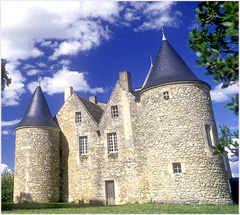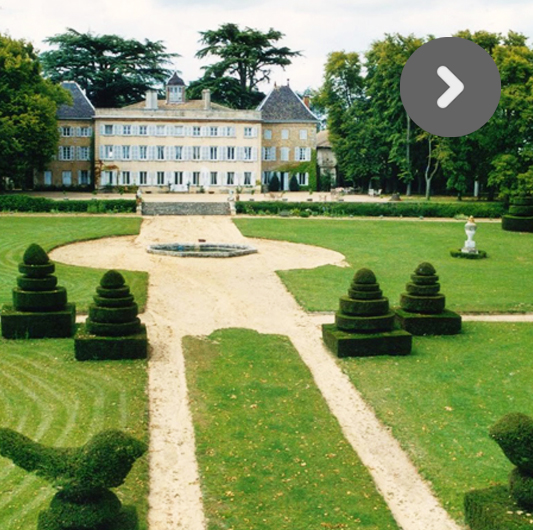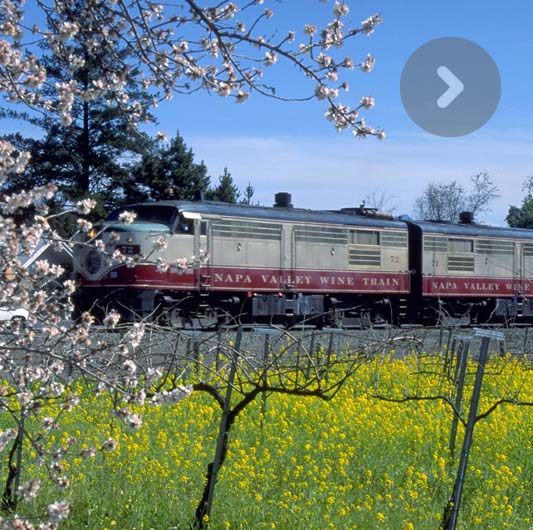Only 15 kilometres separates the villages of Bourg and Blaye. Each one has lent its name to a wine region: the Bourgeais and the Blayais. Two territories separated by the Brouillon stream, each with its own appellation: AOC Côtes de Bourg and AOC Côtes de Blaye, to which should be added the Bordeaux Supérieurs and the Crus Bourgeois.
The vineyards stretch up from the banks of the estuary to the hilltops and terraces from which there is a magnificent view. The proximity to the sea means there is a microclimate. A mild oceanic climate which enables the grapes to mature nicely. These wines are thus gorged with strong character that the winemakers have learnt to tame in order to deliver velvety wines that are softer in depth.
Saint-André-de-Cubzac
The Château du Bouilh
A listed historical monument, the construction of the château was overseen by the same architect renowned for the Bordeaux Opera House, Victor Louis, at the request of Jean-Frédéric de la Tour-du-Pin. The Army Lieutenant General wanted to be able to receive King Louis XVI in a setting appropriate to his rank. Built in the neoclassical style of the eighteenth century, the whole building, with the honorary pavilion and the service quarters, was set in the shape of a hemicycle. One can still admire the remnants of the original manor house, what is called a ‘fuie’ locally: an impressive dovecote which stood 12 metres high and would welcome up to 1200 pigeons, an ostentatious sign of wealth and power at the time. The château now belongs to the Feuihade de Chavin family who organise tours of the estate, including the former wine store and casks. By appointment. www.chateaudubouilh.jimdo.com

Saint-Laurent d’Arce
Château de L’Hurbe. Built in the eighteenth century, the château, which belonged to the Countess Léonie de la Roque de Mons, would produce 100 barrels of white wine a year. A much appreciated white wine, which was commended at the Universal Exhibition in Paris. In 1921, the estate was taken over by Marc Bousseau, grandfather to the current owner, and saw its production diversified. Today, Marc and Agnès Bousseau produce an even wider range of wines: Bordeaux Supérieur, Bordeaux Blanc, Bordeaux Clairet, Crémant de Bordeaux. Their Côtes de Bourg Château de l’Urbe is powerful and develops aromas of blackcurrant. The château welcomes visitors to the park and wine store throughout the year and organises walks in the vineyards as well as Open Days in May and June. By Appointment. www.chateaudelhurbe.fr
Virsac
Saint Genès Church. The Roman church, built between the eleventh and twelfth centuries was renovated in the Gothic style. Both the magnificent nineteenth century cast iron communion gate and the eighteenth century stone cross have been listed historical monuments.
![]()
Château Julie. This former winemaker’s house, situated on the route to Compostella, would welcome pilgrims. Today, it is merely the wine lover’s stop. In the middle of the wine region where the Garonne and Dordogne rivers meet, Renée and Rinsse, a Dutch couple, have thrown their heart and soul into Château Julie. The château has been renovated and includes nine guest rooms and the couple host a table d’hôte with regional fare and tastings of Côtes de Bourg wines. www.chateau-julie.com
Tauriac
Château Brulesecaille. A name that is strongly connected to the land and which means in the old gascon language to cut, carve and burn the prunings. All this, the work of the wine maker. Jacques and Martine Rodet’s wines are situated in the heart of Côtes de Bourg territory. Their Cru Bourgeois dates back to the nineteenth century. A 26 hectare vineyard planted with merlot noir, cabernet sauvignon, cabernet franc and some malbec vine plants, some of which are over 75 years old. The 2009 Château de Brulesecaille blend has a dark violet colour. Heady, spicy, tannic, it can be kept 10 years in a cellar before being tasted. Visit of the estate and wine store, and tastings, by appointment. www.brulesecaille.com
Samonac
Château Macay. It is here, in Samonac, on the hillsides on the right bank of the River Gironde that Sir Mac Kay, a Scottish officer, decided to take up residence in the eighteenth century. The Château Macay was to his liking and so he traded his land and whisky for some vineyards and a glass of Bordeaux. In the nineteenth century, the château was turned into a small wine making village with a two storey wine store, a cooperage and a forge. Each of the trades involved in wine making was represented. The wine store has pretty much remained in its original state and one can imagine the work of the wine growers of that time. Eric and Bernard Latouche, brothers and heirs to the estate with 32 hectares of vineyards pride themselves on producing typical wines from typical plots. Made from highly matured grapes, the 2006 Château Macay Côtes de Bourg is a fine example. It expresses roundness and opulence with a bite of blackcurrant, prune and cherry. Characteristic traits for a Côte de Bourg. Visits by appointment. www.chateau-macay.com
Saint-Seurin-de-Bourg
Château Tayac. While only remnants can be seen of the former watch tower, the château Tayac holds dear the memory of its owner, the Kingsman Edward de Woodstock, known as the Black Prince. Having annexed the city of Bourg in 1356, the Prince, newly made Governor of Guyana, transformed Tayac into a fortified castle. Situated at the confluence of the Garonne and Dordogne rivers, Tayac benefits from an exceptional standpoint and a microclimate favourable to vines. Pierre Saturny, a local, took over the ownership of the estate in 1859 and developed it. His heirs have inherited from 33 hectares and three blends: the Rubis du Prince Noir, the Cuvée Réservée and the Prestige. In 2001, they produced Les Terraces, a young blend with lighter merlot grapes, to be enjoyed on any occasion. Visits by appointment. www.chateau-tayac.fr
Bayon
Château Falfas. Built between the fourteenth and fifteenth centuries, the magnificent château de Falfas belonged to the Lords of Lansac, ancient nobility of the sword, who swore allegiance to the English crown. To reward them for their loyalty, their wines took preference at the court of King Edward. In the seventeenth century, the Lords of Rivaux took over the estate and remodelled the château in pure Louis XIII style, a remarkable achievement. John and Véronique Cochran are the proud bearers of the wine’s prestige and reputation today. A wine that has been classified amongst the top four Grands Crus of the Bourgeais. Since 1988, the entire vineyard is cultivated bio-dynamically to preserve the environment and the consumer. The soil is worked on according to the golden rules. These wines, so rich and dense, are simply a reflection of the character and typicity of the land. According to the Gault & Millau guide, the Les Demoiselles de Falfas 2010 vintage boasts “a velvety texture, gorging with fruit, and a sensual fabric blended with fine notes of truffle and warm earth”. Visits and tastings by appointment. www.chateaufalfas.com
Bayon Church. The steeple of this Roman church is topped with an impressive statue of the Virgin Mary designed by the Bordeaux sculptor Mora in the nineteenth century. Inside, one can admire a seventeenth century painting by the School of Poussin and a marble table anchored into the wall, thought to be of paleo-christian origin.
Villeneuve
Mille Secousses castle
 The château Mendoce, built in 1636 for Jean de Ridder, a trader in Dutch wines, is better known as the château “Mille Secousses”, a royal moniker! When the château was honoured by the visit of a young Louis XIV, accompanied by Mazarin and his mother Anne of Austria, the road was so coarse that the future Sun King was shaken a thousand times and complained about it. The château has a fetching look to it, with its corner towers pierced with embrasures and topped with watch turrets. Its Bordeaux Supérieur offers a thousand gustative pleasures. The current owner Philippe Darriccarère, a pharmacist who pawned his shop for vines, will be delighted to take you round his castle and share with you his passion for wine. Visits and tastings by appointment. www.mille-secousses.com
The château Mendoce, built in 1636 for Jean de Ridder, a trader in Dutch wines, is better known as the château “Mille Secousses”, a royal moniker! When the château was honoured by the visit of a young Louis XIV, accompanied by Mazarin and his mother Anne of Austria, the road was so coarse that the future Sun King was shaken a thousand times and complained about it. The château has a fetching look to it, with its corner towers pierced with embrasures and topped with watch turrets. Its Bordeaux Supérieur offers a thousand gustative pleasures. The current owner Philippe Darriccarère, a pharmacist who pawned his shop for vines, will be delighted to take you round his castle and share with you his passion for wine. Visits and tastings by appointment. www.mille-secousses.com
Château Sauman. The château Sauman has been in the ownership of the Sinan-Braud family for over five generations. Sailors originally, they would travel the world’s seas and anchor up at Sauman. Around 1900, they abandon the sea and turn their ambitions to wine growing on their beautiful land in the Bourgeais. The property is transformed into a wine estate and all the family take part in the process. Dominique takes care of the land planted almost entirely with merlot plants. Véronique vinifies full bodied and fruity reds and Claudine runs the estate. Of Côtes de Bourg tradition, the original blend, light with melted notes of dark and very ripe fruits, remains their wine of reference. A great classic of the estate, the Particulière Côtes de Bourg blend, the first vintage of which dates from 1989, is reserved to only those exceptional years. A confidential blend, elegant and fine, with aromas of dried flowers, roses and mild spices. A very classy wine. Guided visits of the vineyard and of the wine store, Monday to Friday by appointment. www.chateausauman.com
Berson / Saint Gervais

Access to Ladies & Wine
Domaine de Cantemerle Christian, Christophe and Laurent Mabille are independent wine growers who form a fantastic trio. They own 60 hectares of vineyards in appellation AOC Bordeaux Supérieur Rouge. A great vineyard, which received the sustainable agriculture qualification and the “Terra Vitis” label in 2009. All three main grape varieties are represented, in addition to which they grow a small amount of petit verdot and malbec. The Grains de Terroir blend, produced from all five grape varieties is a great success. Visits and tastings by appointment. www.domaine-cantemerle.com
Prignac-et-Marcamps
Grotte de Pair-Non-Pair A prehistoric cave at the bottom of a small valley, which was discovered in 1881. This rich Palaeolithic site revealed tools, carved stones as well as remnants of bisons, aurochs, bears and lions. The mammoths, horses and ibexes are represented in great number on the rock engravings. The region was already densely populated!









